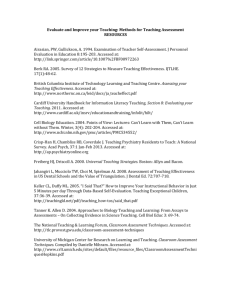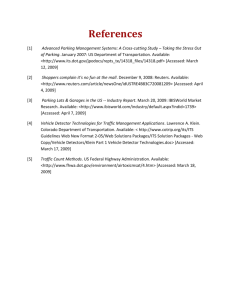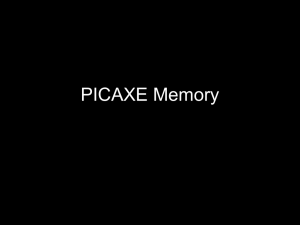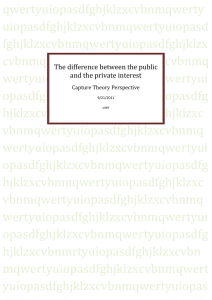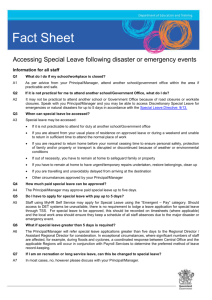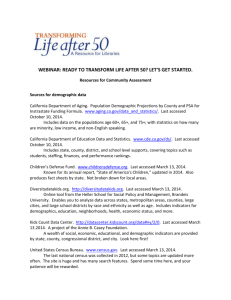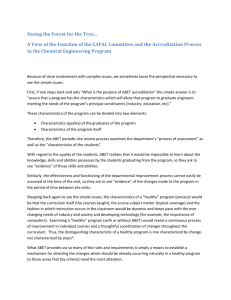II. Outcome (d) Overview
advertisement
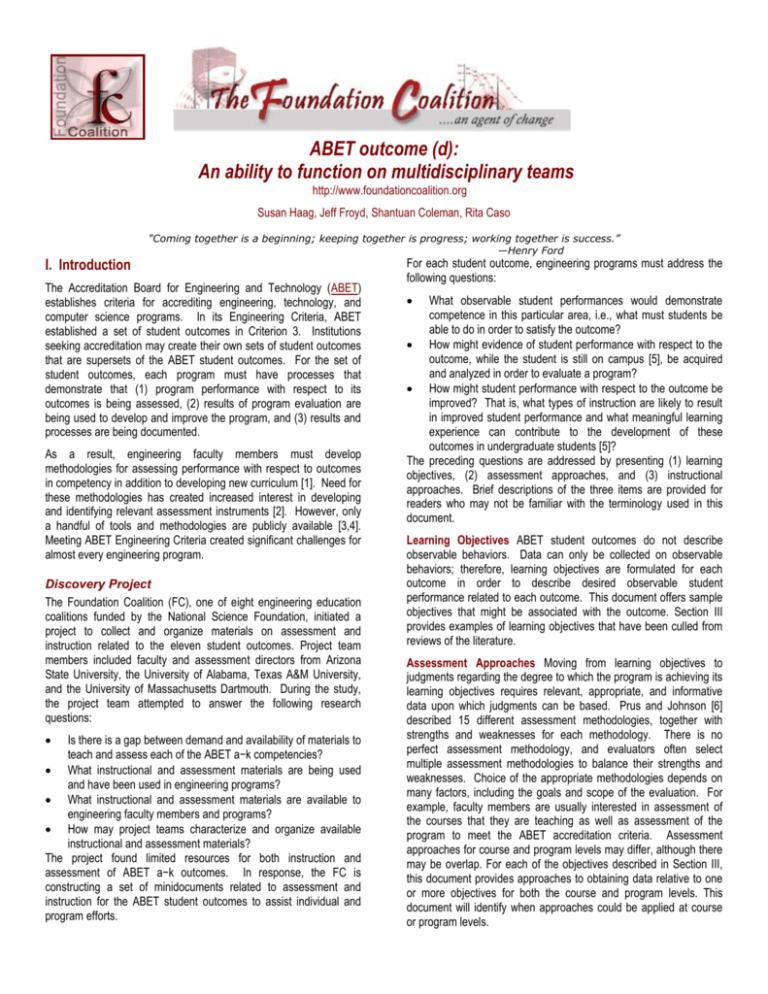
ABET outcome (d): An ability to function on multidisciplinary teams http://www.foundationcoalition.org Susan Haag, Jeff Froyd, Shantuan Coleman, Rita Caso I. Introduction "Coming together is a beginning; keeping together is progress; working together is success.” —Henry Ford The Accreditation Board for Engineering and Technology (ABET) establishes criteria for accrediting engineering, technology, and computer science programs. In its Engineering Criteria, ABET established a set of student outcomes in Criterion 3. Institutions seeking accreditation may create their own sets of student outcomes that are supersets of the ABET student outcomes. For the set of student outcomes, each program must have processes that demonstrate that (1) program performance with respect to its outcomes is being assessed, (2) results of program evaluation are being used to develop and improve the program, and (3) results and processes are being documented. As a result, engineering faculty members must develop methodologies for assessing performance with respect to outcomes in competency in addition to developing new curriculum [1]. Need for these methodologies has created increased interest in developing and identifying relevant assessment instruments [2]. However, only a handful of tools and methodologies are publicly available [3,4]. Meeting ABET Engineering Criteria created significant challenges for almost every engineering program. Discovery Project The Foundation Coalition (FC), one of eight engineering education coalitions funded by the National Science Foundation, initiated a project to collect and organize materials on assessment and instruction related to the eleven student outcomes. Project team members included faculty and assessment directors from Arizona State University, the University of Alabama, Texas A&M University, and the University of Massachusetts Dartmouth. During the study, the project team attempted to answer the following research questions: Is there is a gap between demand and availability of materials to teach and assess each of the ABET a−k competencies? What instructional and assessment materials are being used and have been used in engineering programs? What instructional and assessment materials are available to engineering faculty members and programs? How may project teams characterize and organize available instructional and assessment materials? The project found limited resources for both instruction and assessment of ABET a−k outcomes. In response, the FC is constructing a set of minidocuments related to assessment and instruction for the ABET student outcomes to assist individual and program efforts. For each student outcome, engineering programs must address the following questions: What observable student performances would demonstrate competence in this particular area, i.e., what must students be able to do in order to satisfy the outcome? How might evidence of student performance with respect to the outcome, while the student is still on campus [5], be acquired and analyzed in order to evaluate a program? How might student performance with respect to the outcome be improved? That is, what types of instruction are likely to result in improved student performance and what meaningful learning experience can contribute to the development of these outcomes in undergraduate students [5]? The preceding questions are addressed by presenting (1) learning objectives, (2) assessment approaches, and (3) instructional approaches. Brief descriptions of the three items are provided for readers who may not be familiar with the terminology used in this document. Learning Objectives ABET student outcomes do not describe observable behaviors. Data can only be collected on observable behaviors; therefore, learning objectives are formulated for each outcome in order to describe desired observable student performance related to each outcome. This document offers sample objectives that might be associated with the outcome. Section III provides examples of learning objectives that have been culled from reviews of the literature. Assessment Approaches Moving from learning objectives to judgments regarding the degree to which the program is achieving its learning objectives requires relevant, appropriate, and informative data upon which judgments can be based. Prus and Johnson [6] described 15 different assessment methodologies, together with strengths and weaknesses for each methodology. There is no perfect assessment methodology, and evaluators often select multiple assessment methodologies to balance their strengths and weaknesses. Choice of the appropriate methodologies depends on many factors, including the goals and scope of the evaluation. For example, faculty members are usually interested in assessment of the courses that they are teaching as well as assessment of the program to meet the ABET accreditation criteria. Assessment approaches for course and program levels may differ, although there may be overlap. For each of the objectives described in Section III, this document provides approaches to obtaining data relative to one or more objectives for both the course and program levels. This document will identify when approaches could be applied at course or program levels. II. Outcome (d) Overview Outcome assessment is a method for determining whether students have learned, have retained, and can apply what they have been taught. Assessment plans have three components: a statement of educational goals, multiple measures of achievement of the goals, and use of the resulting information to improve the educational process. The results of outcomes assessment are part of a feedback loop in which faculty members are provided information that they can use to improve their teaching and student learning [7]. For example, after industry provides feedback on the co-op student or intern, faculty members and administrators can determine if their program and courses within the program are effectively teaching teaming skills and appropriately providing opportunities for students to practice teaming skills in class and on course projects. Being able to function on diverse teams is highly valued by engineering organizations. The ability to share knowledge with others while being open to new and creative solutions to problems greatly impacts academic and professional careers of engineers. Engineering practice will continue to require working on diverse teams; thus, teamwork is one of the most sought-after characteristics of a new hire. Criterion 3 of the ABET Engineering Criteria requires “(d) an ability to function on multidisciplinary teams” [1]. The success of a team relies on the effective and efficient effort of each team member. Abilities required to function successfully on high-performance teams include self-management, collaboration, conflict management, communication, and decision making [15]. These abilities can be developed through monitoring, evaluating, and adjusting performance with respect to these abilities. Therefore, graduate require knowledge of these abilities, practice in applying them, feedback about how well they are doing, and practice in improving abilities with respect to these characteristics. Designing a program-level assessment, collecting assessment data on an outcome, and analyzing the results may be complex and less objective than technical research; however, the goal is clear: to determine as reliably as possible if the objectives have been met and, if not, to what should be done to improve each student’s educational experience [8]. III. Learning Objectives Instructional Approaches The ABET a−k outcomes include technical and non-technical (or “soft”) skills that faculty members are expected to teach and therefore measure. Improving performance with respect to skills, as opposed to transferring information, requires alternative approaches to instruction [9]. For example, research shows that students need to do more than take notes while listening in order to learn [10]. Woods et al. [11] showed that students do not develop problem-solving skills by (1) watching faculty members work problems, (2) watching other students work problems, or (3) working many problems (even open-ended problems) themselves. Instead, problem-solving skills are learned in a workshop environment. Seat and Lord [12] state that interaction skills (a subset of team skills) cannot be learned by osmosis or simply working in groups. Interaction skills must be taught explicitly. Students need opportunities to develop and practice soft skills. Student-student interaction is an effective way to learn and is often neglected in the traditional lecture course [13]. The four example objectives below do not encompass the entire outcome; however, they provide examples of learning objectives for which instructional and assessment approaches can be provided. Students will be able to identify specific behaviors and skills that support team effectiveness [15]. Students will be able to analyze different interpersonal style types and evaluate the pros and cons relative to team performance [16]. Students will be able to function effectively on a team [17]. Students will be able to demonstrate teaming behavior and skills while generating ideas [18]. Each objective will be examined individually in the following sections. An introduction, along with sample instruction and assessment approaches, will be given for each objective. These examples can be used to generate ideas to match the needs of each subject area. Teaching critical knowledge, skills, and attitudes required for outcomes a−k must be student centered, where the teaching faculty members are viewed as coaches, facilitators, and guides in the learning process. Learning activities that reflect real-world situations must engage students in individual and collaborative problem solving, analysis, synthesis, critical thinking, and reasoning. New teaching and learning approaches that heighten practical learning and allow students to demonstrate the application of their studies to real-world situations must be put to use [14]. For each learning objective described in Section III, this document suggests instructional approaches for improving student performance. IV. Objective 1: Identify Team Effectiveness Students will be able to identify specific behaviors and skills that support team effectiveness. A. Introduction Effective teams are constructed through complex, intricate interactions. Although effective team performance cannot be prescribed, types of behaviors that limit and/or enhance team performance can be identified. For example, civil engineering faculty members at Southern Illinois University have listed ten behaviors that limit effective team performance [19]. Mark Burns at Auburn University provides tips for promoting effective teams [20]. Students should be able to identify behaviors that either enhance or limit team performance. Students then need to process how their team has functioned on a particular assignment and connect their behaviors to behaviors that limit and/or enhance team performance. In this document Section II presents an overview of outcome (d), “an ability to function on multidisciplinary teams.” Section III provides examples of learning objectives associated with outcome (d) that have been drawn from the literature. Then, the following sections describe instructional and assessment approaches for each of the learning objectives listed in Section III. Each of these sections provides an introduction, suggested instructional approaches, and possible assessment approaches. The final two sections provide resources and references. B. Instruction Many students have had previous experiences (both positive and negative) with teams, and instructors can draw from these experiences to elicit behaviors that limit and enhance team 2 performance. For example, an instructor can facilitate a brainstorming session in which students generate a list of characteristics they believe are important to the success of a team. Students could also describe problems they have had working on a team and generate ideas on how to avoid/resolve them. Based on results from the discussion, the instructor could compile the following and provide a copy to each student: A. Introduction Teams consist of individual members who all have different communication, learning and problem-solving styles. The strength of a team is determined by how well the diverse individual talents and strengths are utilized. Appreciation of the strengths that diverse styles and skills bring to a team and learning to address the challenges involved in achieving common goals is essential for the success of teamwork. A first step in working with diverse members is helping each member to obtain a clearer picture of her/his interpersonal styles. Then, learners are better prepared to learn about, describe, and work with interpersonal styles of the other team members [15]. A list of important characteristics of successful teams Potential problems that can occur when working on teams Ideas for how to avoid/resolve problems The article “Getting Student Engineering Teams off to a Good Start” [21] provides examples of how instructors might solicit ideas from students and then provides information on roles, codes of cooperative, constructing standards for expected behaviors, etc. Other skills required to effectively function on a multidisciplinary team include interpersonal communication and conflict management skills. Examples of exercises that can be used to improve interpersonal communication, conflict management, and team decision-making skills may be found in three Foundation Coalition minidocuments [22−24]. Seat and Lord [12] describe a program for teaching interaction skills (interviewing, questioning, exchanging ideas, and managing conflict) to engineers and engineering students. The program builds on problem-solving strengths to teach interaction skills. For a more complete picture of a minor in Engineering Communication and Performance, see the article by Seat et al. [25]. Richardson [26] has assembled a three-lecture module on team skills (motivation for team skills, listening, sharing your ideas within a team, structuring meetings, and managing conflicts) that is designed to be incorporated into any engineering course. B. Instruction The BESTEAMS project [31] provides a framework for organizing instructional material on teams. The BESTEAMS framework has three components: personal awareness, interpersonal effectiveness, and project management. The BESTEAMS project has developed materials for all three components. “At the core of team effectiveness is the fundamental need for members to understand themselves and others” [32]. To promote greater understanding of personal approaches, the BESTEAMS project has identified the following instruments “to assist in identifying personality types and learning styles”: Myers Brigg Type Indicator (MBTI) [33], Kolb Learning Cycle [34, 35], Felder-Silverman Learning Style Model [36], DISC Behavioral Profile [37], and Hermann Brain Dominance Instrument (HBDI) [38]. Woods et al. at McMaster University offer other instruments for their unit on “Personal Preference: The Unique You” from the McMaster Problem Solving (MPS) Program [39]: Perry inventory [40], Kirton AdaptationInnovation Inventory [41], and Lancaster Approach to Learning questionnaire [42]. The MPS includes a set of learning objectives for the unit on Personal Preference [43]. Yet another instrument is the Attentional and Interpersonal Style Inventory [44]. Identifying ways to improve processes associated with teamwork is beneficial in maximizing student learning and provides a means of continuous team improvement [27]. Upon completion of the project, teams write a report on characteristics that played an important role in the success of their team. In the report, students describe problems that came up with their team and how they resolved them. Although characteristics and problems/solutions may include those mentioned in the class discussion, additional examples may be used. As an example, students at Michigan State University work in diverse teams on a design project, assess themselves, and provide feedback on the success of the team, which includes the involvement of all team members and the achievement of their goal. Prior to class, students read an article on Team-based Design [45] and use an instrument (either Myers Briggs or the Attentional and Interpersonal Style Inventory) to determine their “team style type.” Students are asked to bring their “team style type” to class. C. Assessment Assessment of the skills that support effective teams is still a work in progress. Powers et al. have developed the Team Knowledge Test to measure the degree to which students have retained their knowledge of team behaviors [28]. Jack McGourty has authored Team Builder [29], an electronic system to facilitate peer assessment of team skills. Faculty members might use Team Builder for assessment at both the course and program levels. For formative assessment, i.e., assessment that provides data to be used in improving a course or module, the FC has developed a Team Process Check [30], which is a self assessment of team functioning. The Team Process Check would be appropriate at the course level and also at the program level, if used in conjunction with a capstone project. The instructor leads a discussion about teams and asks: V. Objective 2: Work on a Diverse Team What are some pros and cons of teams? Diversity has many dimensions: gender, ethnicity, backgrounds, personalities, sexual preferences, religious beliefs, skill levels, etc. What are some advantages and disadvantages of diverse and nondiverse teams? Has anyone ever worked on a team that was diverse or nondiverse and run into any of these advantages and disadvantages? (The instructor asks the student to describe the situation.) The instructor assembles teams for a class design project. Teams are based on diverse groups indicated by results on the “team style type” test. The instructor should be sure to put students with different results on the same team to form a diverse team. To work on the Students will be able to analyze different interpersonal style types and evaluate the pros and cons relative to team performance. Students will be able to function effectively on a team whose members have diverse backgrounds and capabilities. 3 second component of the BESTEAMS framework, interpersonal effectiveness, the instructor provides short instruction on effective teams during each class session throughout the design project and encourages students to share issues they have had working with their team. Students receive assessment forms to prepare themselves for self assessment and/or assessment of team members and the leader. 1. 2. 3. 4. Was Involved in the Meeting(s) Provided Positive/Useful Input Stayed On Task During Meeting(s) Arrived On Time/Stayed Until End Lo------Hi 12345 12345 12345 12345 Figure 1. Sample items from the team member evaluation form Students are asked to provide specific details with each rating. The team meets and discusses the results. Students are instructed to use the guidelines for providing feedback outlined in the Team-based Design handout [44]. Working on diverse teams requires competence not only in personal awareness of differences in style and background but also in skills such as listening and conflict management. These skills are grouped under the second component of the BESTEAMS framework, interpersonal effectiveness. Resources for interpersonal communication [22], conflict management [23], and interaction skills [12] were mentioned in the previous objective. The BESTEAMS project also provides resources for interpersonal effectiveness. For teaming experiences throughout the course, team members rotate through the various roles. The role of evaluator provides written feedback on the team’s solution in comparison with the formal solution. This feedback regarding the error and areas where problems were encountered is given to the instructor for examination. The instructor should monitor the progress of each group and bring important points to the group’s attention [15]. A sample exercise from Arizona State University [46] shows how students can identify and address possible problems within a team, such as someone not pulling their weight. The exercise is titled “Anticipating problems” and requires teams to generate a list of potential problems that might occur within a team, categorize the list, and generate ideas on how they can be addressed. Richer, though less systematic, data might be collected through student journals. One example of a journal is requiring each student to respond to a question related to her/his perception of her/his performance on the team. For example, at the end of this project, students might be asked to respond to the following question: “What do you think you have contributed to your team?” The journal entries provide timely feedback to the instructor on how the team is functioning, as well as promote reflective learning for the students [45]. Journaling is appropriate at the course level in conjunction with teaming exercises and practice. Teaming experiences should be structured so that students’ different personality styles, approaches to work, or knowledge base can be highlighted [47]. The instructor should make sure that all members of the team are actively involved in the teaming processes and that group roles are rotated. The group roles include leader, recorder, materials person (when applicable), and an evaluator. VI. Objectives 3 and 4: Demonstrate Teaming Students will be able to function effectively on a team and demonstrate teaming behavior and skills while generating ideas. C. Assessment Data for personal awareness or interpersonal effectiveness need to come from observation on teams in action. Although experiments can be conducted with external observers, data can only be obtained on a routine basis from team members observing themselves in action. In addition to data that might be obtained from peer assessment, graduates who practice in industry will be asked to evaluate peers, superiors, and subordinates. Therefore, students need to develop skills in evaluating peers through practice with feedback. A. Introduction Students learn teaming skills by practicing those skills through direct experiences of the team process [47]. There are many skills that team members require to effectively function on a team: generating ideas, decision making, resolving conflict, etc. Instructors might provide practice and assess skills in one or more of these areas. B. Instruction This instructional example will focus on generating ideas in a team [16]. The instructor places students in teams and distributes one office-supply item to each team (paper clip, stapler, page holder, etc.). In a given time frame, teams write down as many practical uses for their item as possible, using the following guidelines for developing a team response: (1) Brainstorm individually to create a list of your ideas, (2) read your ideas to your teammates; combine similar ideas and form a single list for the group, (3) eliminate, edit, and prioritize your ideas using a criterion of practicality, and (4) prepare a final statement to share with the class. Teams are given a specified amount of time to choose the best use for the item. Each team presents their “invention” to the rest of the class, and the class votes for the best invention. This process allows each individual to contribute and merge ideas to form a team consensus. This exercise is very similar to a lesson from Intel [51]. To assist in collecting systematic peer assessment data, an instructor will either design a form or use an existing form. For course assessment, data can be collected from teams after any class project. For program assessment, data should be collected from a project or projects that represent the culmination of the program. Capstone projects and internships or co-op experiences near graduation are excellent candidates for sources of data for program evaluation [16]. Once the project experience has been selected, the remaining tasks are to design the forms, collect the data, and evaluate the data. Team Builder [29] is commercially available and designed for collection via the World Wide Web. Another example is the collection of Team [48], Member [49], and Leader Evaluation [50] forms used at Michigan State University. A sample of the Team Member Evaluation Form is shown in Figure 1. Team Member Evaluation Form C. Assessment Assessment of learning objectives 3 and 4 requires identifying one or more experiences in which students would apply the skills to be Person Being Evaluated: _____________ Self? _____ (check if evaluating yourself) Date(s) of Meeting(s): ____________________________________ Evaluate your own/other member's performance as a team member using the following criteria and rating scales: 1 (Lo) - 5 (Hi) [Circle One Number on Each Line] 4 assessed. Then, the instructor collects documentation related to the performance of the selected skills. Assessment examples provided in the earlier sections would also be appropriate for learning objectives 3 and 4. Access this resource for activities that demonstrate the importance of various teaming attributes. In one activity, participants rely on teamwork to build a tower out of newspaper. Resource 4 http://www.gamesforgroups.com/teamwork.htm, accessed 5 November 2004 This site provides several activities for building teamwork. In one example, participants are asked to work as a team to stack cups using string and a rubber band. Discussion prompts are provided. Employer Surveys and Interviews to Assess Teaming during a Co-op or Internship Experience Another source of data is employers. Surveying employers about students who have graduated and worked for several years is an excellent way to obtained data to evaluate Program Educational Objectives (Criterion 2). In addition, surveying employers about students who are completing cooperative work experiences or internships may be an excellent source of data for performance with respect to Program Educational Outcomes (Criterion 3).With respect to outcome (d), employers may be able to provide data based on a student’s participation on teams in the work environment. Such data may be extremely useful in assessing team skills at the program level. Resource 5 http://www.humanmetrics.com/cgi-win/JTypes1.htm, accessed 5 November 2004 This site provides an on-line test based on the Jung-Myers-Briggs typological approach. Resource 6 http://www.mines.edu/Academic/assess/Resource.htm, accessed 5 November 2004 This Web site from the Colorado School of Mines provides resources for developing assessment plans. Links are provided to departmental assessment plans that currently exist and are publicly available on the World Wide Web. One example of using employer surveys to provide data for Criterion 2 is the on-line employer survey used by the Industrial Engineering Department at Texas A&M University [52]. Faculty members use the data from the survey to help estimate the preparation of their graduates are for the professional workplace. Employers are asked to evaluate employees who have been out of school for at least two years. A similar survey might be used for co-op and intern students. Resource 7 http://www.engr.pitt.edu/~ec2000/grant_papers/Safourtin-IEEE2000Act.pdf, accessed 5 November 2004 This paper presents a systematic approach for evaluating curriculum and for assessing student learning of design knowledge and skills. The approach provides a common framework for articulating individual components of design ability at various levels of understanding. Application planning and assessment for a freshman-level engineering design course illustrates the approach. The survey asks employers to rate two things: (1) mastery of skills/concepts and (2) importance of skills/concepts to success in their company. For outcome (d), employers are asked to rate graduates on the following: The ability to function effectively and provide leadership within an organization as an industrial engineering professional, including an ability to form, facilitate, lead, coordinate, and participate in teams. Resource 8 How Do You Measure Success: Designing Effective Processes for Assessing Engineering Education At the end of the survey, an open-ended question is asked: Are there any skills/concepts we should be teaching but aren't? This on-line book compiles assessment articles from ASEE PRISM magazine to provide engineering educators with resources. Similarly, the University of Central Florida has an employer survey that asks employers to rate the importance of and satisfaction with graduates’ abilities to work in teams [53]. Resource 9 http://ece.eng.ua.edu/ecedoc/abet.pdf, accessed 5 November 2004 VII. Resources The University of Alabama’s electrical engineering department has a Web page that provides a summary of the various assessment processes used for continuous improvement of the program. Resource 1 http://clte.asu.edu/active/main.htm, accessed 5 November 2004 The Foundation Coalition Web site provides information on implementing cooperative learning (CL). The site provides an overview of cooperative learning: preparing students for CL activities and helping faculty members prepare and implement CL activities. Resource 10 http://www.me.gatech.edu/me/academics/abet/Tab10Methods.html, accessed 5 November 2004 Georgia Tech has created a table of various methods used to measure Program Educational Outcomes. Resource 2 Smith, K.A. (2003). Teamwork and Project Management, second edition. New York: McGraw-Hill The book is an excellent resource for instructors who want to help their students improve teamwork and project management skills. VIII. References 1. Resource 3 http://www.businessballs.com/teambuildinggames.htm#newspaper% 20towers%20team%20building%20games, accessed 5 November 2004 2. 5 Accreditation Board for Engineering and Technology, 2004-05 Engineering Criteria, http://www.abet.org/images/Criteria/E001%200405%20EAC%20Criteria%2011-20-03.pdf, accessed September 2004 McCreanor, P.T. (2001) Quantitatively Assessing an Outcome on Designing and Conducting Experiments and Analyzing Data for ABET 2000, Proceedings, Frontiers in Education Conference, http://fie.engrng.pitt.edu/fie2001/papers/1415.pdf 3. 4. 5. 6. 7. 8. 9. 10. 11. 12. 13. 14. 15. 16. 17. 18. 19. 20. 21. 22. 23. 24. 25. 26. 27. 28. 29. Panitz, B. (1998). Student portfolios. In How Do You Measure Success? Designing Effective Processes for Assessing Engineering Education. Washington, D.C.: ASEE Professional Books, 49–56. Shuman, L., Besterfield-Sacre, M.E., Wolfe, et al (2000). Matching Assessment Methods to Outcomes: Definitions and Research Questions. Proceedings, ASEE Annual Conference, http://www.engr.pitt.edu/~ec2000/ec2000_presentations.html, accessed September 2004 Briedis, D. (2002). Developing Effective Assessment of Student Professional Outcomes. International Journal of Engineering Education, 18:2, 208-216 Prus, J., and Johnson, R. (1994). Assessment & Testing, Myths & Realities. in New Directions for Community Colleges, No. 88, Winter 1994 Shaeiwtz, J.A. (1996). Outcomes Assessment in Engineering Education. Journal of Engineering Education, 85:3, 239 – 246. Olds, B., and Miller, R.L. (1998). An Assessment Matrix for Evaluating an Engineering Program. Journal of Engineering Education, 87:2, 173– 78. Collins, N. F., and Davidson, D. E. (2002). From the margin to the mainstream: Innovative approaches to internationalizing education for a new century. Change, 34:5, 50-59. Chickering, A., and Gamson, Z. (1987) "Seven Principles for Good Practice," AAHE Bulletin, 39:3–7, ED 282 491, 6pp, MF-01; PC-01. Woods, D. et al (1997). Developing Problem Solving Skills: The McMaster Problem Solving Program, Journal of Engineering Education, 86:2, 75-91. Seat, E., and Lord, S. (1999). Enabling Effective Engineering Teams: A Program for Teaching Interaction Skills. Journal of Engineering Education, 88:4, 385-390 Mourtos, N.J. (1997). The Nuts and Bolts of Cooperative Learning in Engineering. Journal of Engineering Education, 86:1, 35 -37. Meier, R.L., Williams, M.R., and Humphreys, M.A. (2000). Refocusing Our Efforts: Assessing Non-Technical Competency Gaps. Journal of Engineering Education, 89:3, 377–385. PITT Attributes for Outcome (d), http://www.engr.pitt.edu/~ec2000/outcomes_html/JM-team-att-d-6-9.htm, accessed June 2004 Pimmel, Russ (2001), Cooperative Learning Instructional Activities in a Capstone Design Course, Journal of Engineering Education, 90:3, 413–421. Felder, Richard; Brent, Rebecca (2003) Designing and Teaching Courses to Satisfy ABET Engineering Criteria. Journal of Engineering Education. Boehm, R.F. and Gallavan, N.P. (2000). Adapting Cooperative Learning to an Introductory Analysis Class. Journal of Engineering Education, 89:4, 419–421. Top 10 List of Group Problems, Civil Engineering Department, Southern Illinois University, http://civil.engr.siu.edu/intro/groupprob.htm, accessed September 2004 Some Tips for Working in Groups, Mark Burns, Auburn University, http://www.auburn.edu/~burnsma/tips.html, accessed September 2004 Getting Engineering Teams off to a Good Start, Foundation Coalition, http://www.foundationcoalition.org/publications/brochures/StartingTeams.pdf, accessed September 2004 Effective Interpersonal/Intrateam Communication, Foundation Coalition, http://www.foundationcoalition.org/publications/brochures/communication.pdf, accessed September 2004 Understanding Conflict and Conflict Management, Foundation Coalition, http://www.foundationcoalition.org/publications/brochures/conflict.pdf, accessed September 2004 Effective Decision Making in Teams, http://www.foundationcoalition.org/publications/brochures/effective_decision_ma king.pdf, accessed September 2004 Seat, E., Parson, J.R., and Poppen, W.A., (2001). Enabling Engineering Performance Skills: A Program to Teach Communication, Leadership, and Teamwork. Journal of Engineering Education. 90:1, 7-12 EC 2000 Teaming Skills, Foundation Coalition, http://www.foundationcoalition.org/home/FCVersion2/professional/teaming.html, accessed September 2004 Johnson, D.W., Johnson, R.T. and Smith, K.A. (1998). Cooperative Learning Returns To College. What Evidence Is there that it works? Change, July/August. Sims-Knight, J.E., Upchurch, R.L., Powers, T.A., Haden, S., Topciu, R. (2001). Teams in Software Engineering Education. Proceedings, Frontiers in Education Conference, http://fie.engrng.pitt.edu/fie2002/papers/1462.pdf McGourty, J., and DeMeuse, K.P. (2000). Team Developer: An Assessment and skill building program. Australia: John Wiley and Sons, http://www.johnwiley.com.au/database/description.cfm?ISBN=0471403849. 30. 31. 32. 33. 34. 35. 36. 37. 38. 39. 40. 41. 42. 43. 44. 45. 46. 47. 48. 49. 50. 51. 52. Team Process Check, Foundation Coalition, http://www.foundationcoalition.org/home/keycomponents/teams/process_check. html, accessed September 2004 Building Engineering Student Team Effectiveness and Management Systems (BESTEAMS) Home Page, http://www.enme.umd.edu/labs/BESTEAMS/, accessed September 2004 Adams, S.G., Mead, P.F., Bigio, D., Schmidt, L., Schmidt, J., Wilkins, G., and Kelley, C. (2001). Effect of Learning Style Diversity on Engineering Teams, Proceedings, Frontiers in Education Conference O’Brien, T., Bernold, L.E., Akroyd, D. (1998). Myers-Briggs Type Indicator and Academic Achievement in Engineering Education. International Journal of Engineering Education, 14:5, 311–315 KoIb, D.A. (1984). Experiential Learning: Experience as the Source of Learning and Development, Englewood Cliffs, NJ: Prentice-Hall, Harb, J.N., Durrant, S.O., and Terry, R.E. (1993). Use of the Kolb Learning Cycle and the 4MAT System in Engineering Education. Journal of Engineering Education, 82:2, 70–77 Felder, R.M., and Silverman, L.K. (1988). Learning and teaching styles in engineering education, Engineering Education, 78:4, 674–681. Marston, W. (1979). The emotions of normal people. Minneapolis: Persona Press, Inc. Lumsdaine, M. and Lumsdaine, E. (1995). Thinking Preferences of Engineering Students: Implications for Curriculum Restructuring. Journal of Engineering Education, 84:2:, 193–204 The MPS program: the McMaster Problem Solving program, http://www.chemeng.mcmaster.ca/mps/ Perry, William G., Jr. (1970), Forms of Intellectual and Ethical Development in the College Years: A Scheme. New York: Holt, Rinehart, and Winston Kirton, M.J. (2003). Adaptation-Innovation: In the Context of Change and Diversity. Taylor & Francis Ramsden, P. (1983). The Lancaster Approaches to Studying and Course Perceptions Questionnaire: Lecturers’ Handbook. Oxford, England: Oxford Polytechnic, Educational Methods Unit Team-Based Design, http://www.egr.msu.edu/classes/ece482/docs/resources/TeamDesign.html, accessed September 2004Personal Preference: The Unique You, Learning Objectives, http://www.chemeng.mcmaster.ca/mps/mps11-obj.pdf, accessed September 2004 Teaming Workbook, http://www.eas.asu.edu/~asufc/teaminginfo/teamwkbk.pdf, accessed September 2004 Lewis, P. Aldridge, D., and Swamidass, P.M. (1998). Assessing Teaming Skills Acquisition on Undergraduate Project Teams. Journal of Engineering Education, 87:2, 149–155. Team Evaluation Form, Michigan State University, http://www.egr.msu.edu/classes/ece482/docs/resources/TeamEval.html, accessed September 2004 Member Evaluation Form, Michigan State University, http://www.egr.msu.edu/classes/ece482/docs/resources/TeamMemberEval.html, accessed September 2004 Leader Evaluation Form, Michigan State University, http://www.egr.msu.edu/classes/ece482/docs/resources/TeamLeaderEval.html, accessed September 2004 Intel Design and Discovery Curriculum, Build a Better Paper Cup, http://www.intel.com/education/design/session01/activity1.htm, accessed September 2004 Online Employer Survey, Industrial Engineering Department, Texas A&M University, http://ie.tamu.edu/Welcome/Employer_survey.htm, accessed September 2004 Online Employer Survey, Civil and Environmental Engineering, University of Central Florida, http://www2.oeas.ucf.edu/oeas2/pdf/cee_emp02.pdf, accessed September 2004 Whether you're just getting started or looking for some additional ideas, the Foundation Coalition staff would like to help you incorporate assessment into your engineering classes through workshops, Web sites, lesson plans, and reading materials. For suggestions on how to start, see our Web site at 6 <http://www.foundationcoalition.org> or contact Jeffrey Froyd at froyd@ee.tamu.edu or at 979-845-7574.
